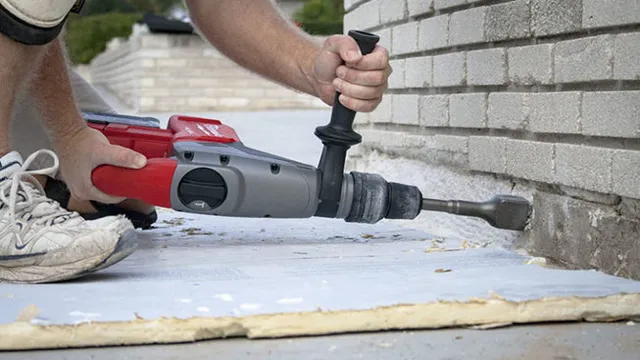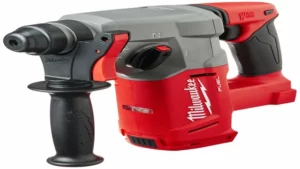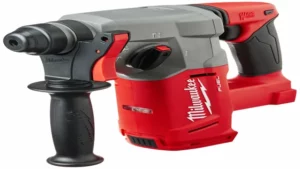Have you ever wondered how professionals can drill through concrete or break up tough surfaces effortlessly? The answer lies in a tool that revolutionized the construction industry, the rotary hammer. Unlike a regular power drill that spins the drill bit, a rotary hammer uses a piston to create a powerful hammering motion that delivers fast and efficient drilling or chiseling. It is an essential tool for professionals dealing with tough surfaces, concrete, bricks, and even stone.
In this blog, we will dive deeper into the mechanics of how a rotary hammer works and how it can benefit your construction projects. Let’s get started!
Overview of Rotary Hammers
Rotary hammers are a tool used to bore holes in tough surfaces like concrete and masonry with ease. So, how does a rotary hammer work? These tools feature a piston that delivers a powerful blow to a bit, which rotates as the hammer drills into the surface. This hammering motion drastically increases the force applied to the bit, making it easier to drill through solid materials.
Unlike regular drills, rotary hammers use a combination of rotation and percussion to bore holes. The force generated by the hammer is so powerful that you can use it for demolition work and chiseling, too. So if you’re a DIY enthusiast or a professional in the construction industry, investing in a rotary hammer will make your drilling and demolition jobs faster and more efficient.
What is a Rotary Hammer?
A rotary hammer is a powerful tool that is used for drilling through hard surfaces such as concrete, masonry, or stone. This tool works by using a piston mechanism that rapidly strikes the drill bit while it rotates, providing a heavy-duty hammering action that can easily break through tough materials. Rotary hammers come in a variety of sizes and designs, from lightweight models for DIY projects to heavy-duty industrial models for professional use.
This tool is perfect for construction workers, handymen, or anyone who needs to drill through tough materials quickly and efficiently. Whether you are building a new home or renovating an old one, a rotary hammer is an essential tool to have in your arsenal. So, if you are looking for a tool that can handle heavy-duty drilling tasks with ease, a rotary hammer should be at the top of your list!

Types of Rotary Hammers
Rotary hammers come in various shapes and sizes, each designed to suit a particular job. There are two primary types of rotary hammers: SDS-plus and SDS-max. SDS-plus hammers are suitable for small to medium-sized projects and are the most commonly used.
These hammers have a drilling capacity of up to 1 inch, making them ideal for use in concrete, brick, and stone. They are lightweight, making them easy to maneuver, and they are also budget-friendly. SDS-max hammers, on the other hand, are bigger and can handle more significant tasks.
They can drill holes of up to 2 inches in size, making them ideal for larger construction jobs. They are generally heavier than SDS-plus hammers, but they are more powerful. SDS-max hammers are usually used in industrial settings or on large construction sites where heavy drilling is required.
Regardless of the type of rotary hammer needed, choosing the right one for your job ensures efficiency, safety, and a job well done.
Internal Mechanisms of Rotary Hammers
If you’re wondering how a rotary hammer works, it’s actually pretty simple. A rotary hammer uses a piston mechanism to deliver a powerful blow to a surface. As the piston moves back and forth, it drives a chisel or drill bit into the material being worked on.
It achieves this by combining a hammering action with a rotating motion. This makes it possible to drill or break through even the toughest of materials, like concrete or brick. The rotary hammer also features an internal mechanism that allows it to absorb much of the shock and vibration that results from the drilling or chiseling action.
This means that the tool is more comfortable and easier to use, especially over extended periods. So if you need to tackle a tough job, a rotary hammer is definitely worth considering!
Impact Mechanism
When it comes to rotary hammers, the impact mechanism that drives the bit into hard surfaces is what sets it apart from regular drills. There are two main mechanisms used in rotary hammers – pneumatic and electro-pneumatic. Pneumatic models use compressed air to create the impact, while electro-pneumatic models use a similar system but with an electric motor powering the air compressor.
Both mechanisms rely on a piston that moves back and forth inside a cylinder, delivering a force that drives the bit into the surface. This piston is driven by a crankshaft that converts the rotary motion of the motor into the linear motion needed for the impact mechanism. The result is a powerful and efficient tool that can handle tough jobs like drilling through concrete and masonry.
Whether you’re a professional contractor or a DIY enthusiast, a rotary hammer with a reliable impact mechanism is an essential tool for tackling challenging projects with ease and precision. So, choose the right tool and get started on your next project today!
Rotation Mechanism
One of the essential internal mechanisms that make rotary hammers so effective is the Rotation Mechanism. It is responsible for converting the rotary motion of the drill bit into a forward hammering action, which is what allows the hammer to chip away at concrete and other tough materials. This mechanism is made up of several components, including the gear mechanism and the crankshaft.
The gear mechanism is responsible for transmitting the rotary motion from the motor to the hammer piston, which then delivers the impact force to the bit. The crankshaft converts that linear force into a rotary motion, which drives the bit through concrete. This mechanism is a critical component of any rotary hammer, and without it, the tool would be unable to deliver the power and impact force required to make holes in concrete and other challenging materials.
Safety clutches
Rotary hammers Rotary hammers are powerful tools that are ideal for drilling through tough surfaces such as concrete. They work by using a combination of rotation and percussive force to break through the material. However, the intense force generated by these tools can sometimes be dangerous to users.
That’s where safety clutches come in. Safety clutches are internal mechanisms that are designed to protect the operator in the event of a malfunction. They work by disconnecting the drill’s drive mechanism if a certain amount of resistance is encountered, preventing the user from being injured by the powerful forces generated by the tool.
This makes rotary hammers much safer to use, especially in situations where the user may not be familiar with the tool or its capabilities. So, if you’re planning on using a rotary hammer, it’s important to make sure that it has a safety clutch and that it’s functioning properly before you start drilling.
Usage of Rotary Hammers
Rotary hammers are powerful tools that are used to drill through tougher materials such as concrete, stone, and brick. They work by combining the pounding force of a hammer with the rotation of a drill, making them highly efficient for heavy-duty tasks. The hammering motion is produced by a piston that moves back and forth inside the cylinder, creating a high-pressure air cushion that drives the drill bit into the material being drilled.
The rotary hammer’s powerful motor and a specially designed chuck help to hold the drill bit in place, ensuring precision drilling. These tools are essential in construction and renovation projects, enabling workers to complete jobs efficiently and effectively. Overall, understanding how a rotary hammer works is essential for anyone working in the building and construction industry.
Suitable Materials for Rotary Hammers
Rotary hammers are powerful tools that are commonly used in heavy-duty construction projects. They are designed to drill through hard materials like concrete, brick, and stone with ease. To ensure that rotary hammers perform optimally, it is crucial to use appropriate materials for the job.
Materials like masonry bits, carbide-tipped bits, and diamond-tipped bits are recommended for drilling through concrete. For brick and stone, bits made from high-speed steel or cobalt may be used. The type of material used will determine the speed and efficiency of the drilling process.
Using the wrong material can result in damage to the rotary hammer and the surface being drilled. Therefore, it is important to choose the right bit for the job and to handle the rotary hammer with care. With the right materials and proper handling, rotary hammers can achieve exceptional drilling results.
Specialized bits for rotary hammers
Rotary hammers are powerful tools that are commonly used in construction and renovation projects. They are perfect for drilling through concrete, masonry, and other hard surfaces. However, to maximize the efficiency of a rotary hammer, it is essential to use specialized bits.
These bits are designed to handle the extreme force and pressure that rotary hammers generate, ensuring that they can penetrate through hard surfaces with ease. Some of the most common types of bits that are used with rotary hammers include masonry bits, hammer drill bits, and chisel bits. Masonry bits are perfect for drilling small holes in concrete, while hammer drill bits are ideal for larger holes.
Chisel bits are great for breaking and chipping through concrete and masonry. Using the right bit for the job is crucial when it comes to getting the job done right the first time around. So, make sure to invest in quality specialized bits when using a rotary hammer to achieve maximum efficiency and precision.
Maintenance of Rotary Hammers
When it comes to the maintenance of a rotary hammer, it’s important to understand how it works. Essentially, a rotary hammer combines the functions of a hammer and a drill to break through concrete and other tough materials. It operates on an inward and outward piston action that applies pressure to the bit, allowing it to chip away at the surface.
To keep your rotary hammer running smoothly, regular upkeep is necessary. This includes keeping the drill bits sharp, lubricating the gears and bearings, and cleaning out any dust and debris that may accumulate during use. It’s also important to check the brushes and replace them when needed to avoid any potential damage to the motor.
By following these maintenance tips, you can extend the life of your rotary hammer and ensure that it continues to perform its job effectively.
Conclusion
In summary, a rotary hammer is like a superhero of power tools. It combines the brute force of a sledgehammer with the precision and finesse of a drill, making it the perfect tool for tough construction jobs. Using a powerful motor, clutch assembly, hammer mechanism, and drill bit, it can pulverize concrete, tear through brick, and bore through wood with ease.
So the next time you see a construction worker wielding a rotary hammer, know that they have a true weapon in their hands, capable of conquering any building material in its path.”
FAQs
What is a rotary hammer and how does it work?
A rotary hammer is a power tool that is used for heavy-duty drilling and demolition tasks. It works by combining rotary drilling motion and a hammering action to break through tough materials like concrete and masonry.
What is the difference between a rotary hammer and a regular hammer drill?
While both tools are used for drilling holes in hard materials, a rotary hammer is designed for heavier applications where a regular hammer drill may struggle. The rotary hammer delivers more force and has a mechanism that provides a hammering action.
How is a rotary hammer powered?
A rotary hammer is usually powered by electricity, either through a corded or cordless connection. The corded versions offer more power and a continuous power supply, while the cordless ones are more portable and easier to use in tight spaces.
What types of bits can be used with a rotary hammer?
Rotary hammers are designed to use SDS (slotted drive system) bits, which have a unique grooving pattern that allows for quick and easy bit changes. SDS bits come in various sizes and shapes, including pointed, chisel, and flat blades.
What safety precautions should be taken when using a rotary hammer?
When using a rotary hammer, it is essential to wear proper safety gear, including eye and ear protection. It’s also important to follow the manufacturer’s instructions carefully, especially when it comes to inserting and removing bits. Additionally, make sure the work area is clear of debris and that the tool is kept out of reach of children.
How do you maintain a rotary hammer?
To keep your rotary hammer in good working condition, it’s essential to clean it regularly and store it in a dry place. Also, make sure to lubricate the moving parts of the tool to prevent rusting and to change the brushes when they wear out.
Can a rotary hammer be used for tasks other than drilling?
Yes, rotary hammers can also be used for chiseling and demolition tasks. Some models come with various attachments for different types of work, including scraping and brushing. However, it’s crucial to ensure you have the correct bit or attachment for the task at hand.






